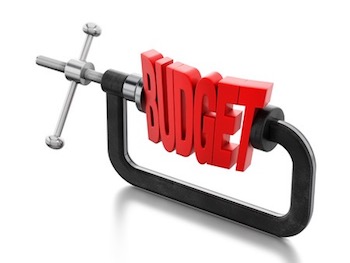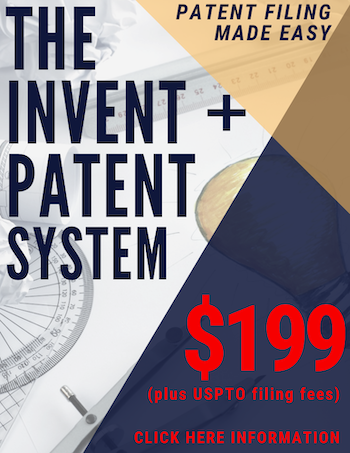 The patent process can be overwhelming and quite costly for an inventor who wishes to secure patent protection on their invention. But there are certain steps of the process that should not be neglected because of financial constraints, otherwise your efforts could actually be counterproductive and work against you in the end. The nightmare scenario is cutting corners too sharply and then finding out that the project has been so compromised that the money you did spend has been wasted.
The patent process can be overwhelming and quite costly for an inventor who wishes to secure patent protection on their invention. But there are certain steps of the process that should not be neglected because of financial constraints, otherwise your efforts could actually be counterproductive and work against you in the end. The nightmare scenario is cutting corners too sharply and then finding out that the project has been so compromised that the money you did spend has been wasted.
While the economy has improved from the depth of the financial crisis, the improvement has been uneven and many still do not feel as if much has really improved. People are working harder, longer hours, two jobs (or more) and wages haven’t been rising to keep up with inflation. In times like this it is not at all uncommon for increasing numbers of people to start dusting off their old invention ideas and working on them in hopes that a new invention will help propel them to financial independence. The problem is these inventors are also often the ones that have little disposable income with which to protect their inventions. It is a Catch-22 situation.
One inventor recently gave us a specific dollar amount he could afford to spend to obtain a patent, stating that “I need it to cost under $600, because that is all I have to spend.” Unfortunately, with a budget like that there just isn’t a lot anyone will be able to do to help. The filing fees payable to the United States Patent and Trademark Office alone are $130 for a Provisional Patent Application (assuming small entity status, and $65 for micro entity status) and a minimum of $730 for a Non-Provisional Patent Application (assuming small entity status, and $400 for micro entity status) and that is not to mention the cost of drawings, the issue fee that must be paid to the Patent Office when they agree to allow a patent and any number of other fees that will become due to the Patent Office. In other words, even if you qualify as a micro entity, which entitles you to pay 25% of the regular USPTO fees, the fees due just to the federal government will more than eat up a $600 budget and that is if you represent yourself, which can be quite risky. So if your budget is too limited a serious question should be asked about whether it even makes sense to pursue the invention in the first place.
There are ways that inventors can file for patent protection on their inventions with a limited budget, but even then you have to be realistic in the costs of this undertaking. Again, obtaining a patent is a process, and in order to do it right, there are several steps that need to take place and each of these steps will take time and money. You cannot simply write down on a piece of paper what your invention is, and get a patent. If you follow these necessary steps of the process, and use the resources available to you, you can file a fairly well written Patent Application at a somewhat reasonable cost. But keep in mind that even if you are relatively Internet savvy and an educated individual, without the assistance of a Registered Patent Attorney, the chances of things being missed or written incorrectly, increase exponentially. The nightmare scenario is spending what limited resources you have doing it yourself and winding up with a patent or patent application that is worthless.
 One common mistake we hear deals with whether an invention is new and unique enough to be patentable. Many inventors think that if they don’t see their invention on the market or being used in everyday life that their invention is novel. Unfortunately, more often than not that is an incorrect assumption. We highly recommend to all of our clients that they subject their invention to a through patent search to make sure that there is a realistic opportunity to receive a patent. Just because you do not see it on the market doesn’t mean that it or something similar to it hasn’t already been patented. There are lots of reasons why something might not be on the market, but still have patent protection. For example, a lot of times independent inventors will get a patent and then just lose interest or run out of money and nothing ever becomes of the invention they chose to protect. Sometimes people are just adding to their resume of patents; and still others just want to be recognized by the government as an inventor. So, we always recommend starting with a patent search.
One common mistake we hear deals with whether an invention is new and unique enough to be patentable. Many inventors think that if they don’t see their invention on the market or being used in everyday life that their invention is novel. Unfortunately, more often than not that is an incorrect assumption. We highly recommend to all of our clients that they subject their invention to a through patent search to make sure that there is a realistic opportunity to receive a patent. Just because you do not see it on the market doesn’t mean that it or something similar to it hasn’t already been patented. There are lots of reasons why something might not be on the market, but still have patent protection. For example, a lot of times independent inventors will get a patent and then just lose interest or run out of money and nothing ever becomes of the invention they chose to protect. Sometimes people are just adding to their resume of patents; and still others just want to be recognized by the government as an inventor. So, we always recommend starting with a patent search.
Of course, there is nothing wrong with doing your own patent search to start, and you absolutely should do an Internet search to see if you can find it online. If you can find something that is too close for comfort on your own then you’ve saved money because you no longer need to hire a professional search firm. Doing your own search can also help you start to get a sense for the level of information you will need for your own patent, and to become familiar with the industry, all of which are very positive. Before you do your own patent search please see: Patent Searching 101 and Patent Searching 102. Also, please do not assume that just because you cannot find any prior art that means there is none that could be found by a professional searcher. A quality professional search uncovers far more prior art than any inventor could ever locate. See I Can’t Find Any Prior Art.
Once you have completed your search project, and you are pretty certain that there is no prior art close enough to your invention to render your invention not patentable, the first step for those operating on a budget absolutely should be to file a Provisional Patent Application, particularly prior to discussing your invention with companies you think may be interested in your invention including manufacturers, marketing firms, and/or investors. Truthfully, now that the United States is a first to file country the filing of a Provisional Patent Application should be the initial step by practically everyone. Of course, your Provisional Patent Application will need to describe the invention with as much detail and specificity as would be required in a Non-Provisional Patent Application, although the formalities can be satisfied later. A Provisional Patent Application will give you that all important filing date, critical in a first to file world, and a “patent pending” status, which you must keep in mind, is only “perceived protection” in that you will have 12 months to file a Non-Provisional Patent Application, or your application will expire and a patent will never issue. This 12 month window can only be extended in extraordinary situations and after paying a heft fee, so it should really be considered absolute.
The short story is this: done properly there is no downside to a provisional patent application. But like many things in life, there are a few ways to do it right and many ways to mistakenly convince yourself you have done it right. For more on Provisional Patent Applications please see: There is no such thing as a provisional patent, Benefits of a provisional patent application, and The Good, the Bad and the Ugly: Truth about provisional patent applications. If you are going to attempt to tackle a Provisional Patent Application on your own consider using the Invent + Patent System™, which is specifically designed to help inventors create their own Provisional Patent Application for filing with the United States Patent and Trademark Office.
In closing, in order to file a strong, high quality do-it-yourself Provisional Patent Application, you will need to be dedicated to your invention. This is not an endeavor that should be taken on lightly because as I stated earlier, you will need to put in time spent, what you are saving in money spent. If you serious and are willing to put in the time to conduct a thorough patent search, to create and file and well written Provisional application and to have time to devote to developing your invention, you can successfully complete the first few yet very important steps of the Patent Process on a Tight but Realistic Budget.
For more information about drafting a patent application, including tips and tricks, please see:
- Tips & Tricks for Describing Your Invention in a Patent Application
- Working with Patent Drawings to Create a Complete Disclosure
- Patent Drafting: Learning from Common Mistakes
- Patent Drafting: Defining terms when drafting a patent application
- Patent Drafting for Beginners: A prelude to claim drafting
- Patent Drafting: Distinctly identifying the invention in exact terms
- Patent Drafting: The use of Relative Terms can be Dangerous
- Patent Drafting: Identifying the Patentable Feature
- Patent Drafting: Beware Background Pitfalls When Drafting
- Thinking outside the box leads to the best patent applications
- The Key to Drafting Excellent Patents: Alternatives

![[IPWatchdog Logo]](https://ipwatchdog.com/wp-content/themes/IPWatchdog%20-%202023/assets/images/temp/logo-small@2x.png)

![[[Advertisement]]](https://ipwatchdog.com/wp-content/uploads/2018/10/Enhance-1-IPWatchdog-Ad-2499x833-1.png)
![[[Advertisement]]](https://ipwatchdog.com/wp-content/uploads/2018/10/ip-ad_rocket_464.jpeg)

![[Advertisement]](https://ipwatchdog.com/wp-content/uploads/2024/04/Artificial-Intelligence-2024-REPLAY-sidebar-700x500-corrected.jpg)
![[Advertisement]](https://ipwatchdog.com/wp-content/uploads/2024/04/UnitedLex-May-2-2024-sidebar-700x500-1.jpg)
![[Advertisement]](https://ipwatchdog.com/wp-content/uploads/2024/04/Patent-Litigation-Masters-2024-sidebar-700x500-1.jpg)

![[Advertisement]](https://ipwatchdog.com/wp-content/uploads/2021/12/WEBINAR-336-x-280-px.png)
![[Advertisement]](https://ipwatchdog.com/wp-content/uploads/2021/12/2021-Patent-Practice-on-Demand-recorded-Feb-2021-336-x-280.jpg)
![[Advertisement]](https://ipwatchdog.com/wp-content/uploads/2021/12/Ad-4-The-Invent-Patent-System™.png)






Join the Discussion
No comments yet.